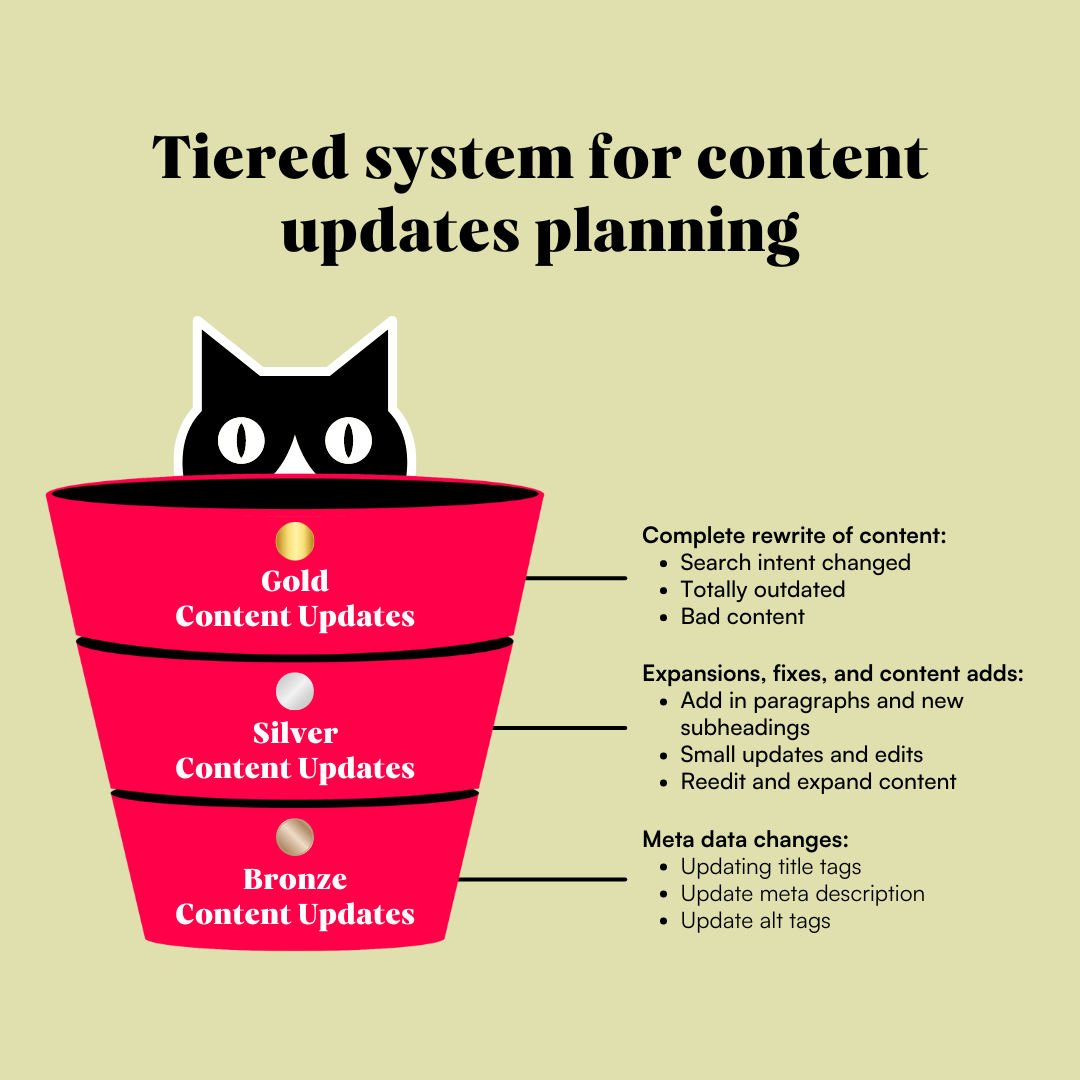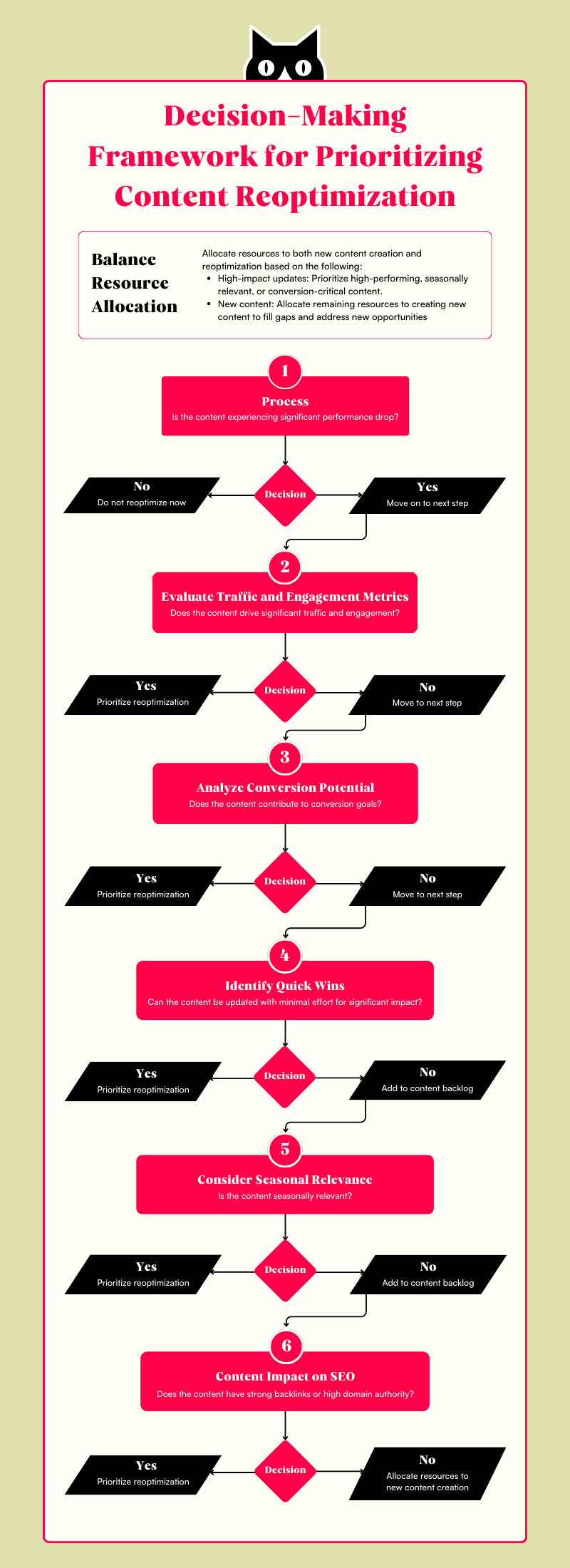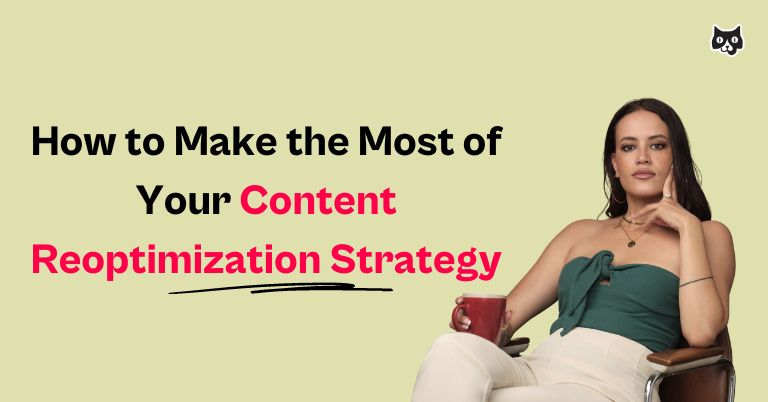Everyone says it: the lowest-hanging SEO fruit is existing content optimization rather than creating anything new. Yet, so many strategies are focused on new content only.
Most people will optimize content when they inherit or start a new SEO responsibility.
A handful of teams do it on some kind of regular cadence.
Few organizations bake it into their ongoing SEO workflows.
In this article, I’m going through how to optimize your optimizations and bake one of the most important elements of ongoing SEO into your workflow.
Top reasons you might need to optimize existing content
I’ll die on the hill that existing content optimization *needs* to be a part of your official SEO or content process.
The point of SEO is that it lowers the cost of acquiring a customer because your content stays online and findable forever, and you don’t have to pay for traffic. So the more you build, the more of a compounding effect it provides.
SEO only compounds if it’s maintenance + growth, not growth alone.
There are 3 primary reasons why you want to update your content:
- Content decay.
- New keyword opportunities.
- Outdated content.
Content decay
Neglecting past content in SEO is like planting a bunch of trees to grow a forest but only continuing to plant new trees instead of watering and nurturing the ones you already have.
The truth is that, even though the value of SEO content compounds and becomes more valuable over time, if left untouched, it starts to decay. Studies have found that most content decays after 1 year and 9 months.
And if you constantly have decaying content, you cannot achieve the exponential growth that SEO is said to offer.
Not to mention—if you leave content to decay naturally, that *one post* that brought all your traffic will, eventually, hit 0.
It’s pretty annoying because we’ve already spent hundreds or thousands on the piece of content… and I’m telling you that you’re going to have to spend more time on it forever to keep it alive.
Why would the world be so cruel?
Here are a few reasons why content decay occurs:
- Algorithm updates
- Search intent changes
- New or updated content from competitors
Algorithm updates
SERPs are known to be volatile, and what worked once can suddenly stop working. Google is always trying to listen to the user and change the SERPs based on what users want.
For example, Lily Ray recently found in a study that Google has completely shifted the SERP prioritization for certain kinds of queries.
For “best of” listicle queries (e.g. “best sleep mask”), Google used to prioritize product review websites, magazines, or bloggers.
Since so many websites were using affiliate marketing as a revenue stream, primarily fueled through SEO traffic, users complained that the top-ranking articles were too “SEO-y”, inauthentic and didn’t actually provide honest reviews.
So Google replaced the SERP with either UGC/forum content or direct ecommerce/product pages. Good for ecommerce, less good for affiliate marketers.
Source: Lily Ray’s LinkedIn post. In this image, red is affiliate/product review sites, orange is UGC/social media site, and green is ecommerce. On the left is January 2024, and on the right is May 2024.
Now this is one reason why a lot of “best of” content has been decaying lately, particularly in the B2C space. Whether you can save your content or not depends on your industry. You may have to take a completely different approach.
Change in search intent
Sometimes search intent itself changes.
For example, when you searched for “face masks” pre-2020, would mostly be people looking for supplies for their at-home spa day. This completely changed in 2020 when “face masks” now meant people were looking for personal protective equipment.
Everyone who ranked highly for the skin-care face masks were annihilated for that keyword.
This happens sometimes—just as language develops, new terms are coined, and new brands emerge, so does the meaning of a search query, and therefore your ability to serve it with the most relevant content.
New or updated content from competitors
Sometimes you might dominate the SERP for months or even years.
But someone else always wants the top position for a keyword, especially if it’s a competitive one with high volume.
At any time, somebody can build a better, more updated piece of content, with more backlinks.
Sure, you climbed up to the top, but you can get knocked off at any time.
The more competitive the keyword, the more likely you’ll have to keep updating the piece of content to fight for your title.
New keyword opportunities
Older content losing its prime isn’t the only reason you’d want to update content—new content has the potential to add hundreds of additional keywords and be far more successful than the first time you’ve published it.
The best way I’ve grown content is to publish, wait 2-3 months, and then check Google Search Console for all the other queries people have found the content through.
In Google Search Console, I can go to a particular page and then click “Queries” to see other queries this page has appeared for. Then, I can add those words into the content to improve visibility, rankings and clicks.
Then, I add those back into the content, through sub-headings if they’re very close to the primary keyword, or throughout the body if not as close.
If the keywords can’t reasonably be used to make this page rank in the top 10, then it’s also a way to do keyword research for brand- new topics and pages that can be created.
Then, I request re-indexing also through Google Search Console.
It helps me rank for far more keywords faster and creates that exponential chart we look for in SEO.
Outdated content
In the last 5 years, the world has gone through so many versions of “unprecedented times” that content has become outdated extremely fast.
We wrote a whole 6-9 months of content for a client that was around COVID-19. Then, we had to change all of the wording and themes on the same content to be around the labor shortage. And then it was about the recession.
If I read anything that talks about how things have changed since the pandemic, it feels completely outdated to me—we have SO moved on to a different set of problems now.
You may also find that you are linking to outdated data and stats. Anything beyond the last 2 years is a stat that you can’t use anymore—the world is changing too rapidly.
Google prioritizes fresh content, and frankly so do you users.
Now that we know reasons to update your content, let’s talk about how to use your analytics platforms to identify what to optimize and why.
Content performance data for re-optimizations
When understanding why and when to reoptimize, you want to know what kind of story you want to tell, and that will lead you to the right data.
Here are the metrics that you want to look for when making decisions:
Drop or plateauing organic traffic
Healthy SEO means the traffic to that page should be growing month over month.
If it starts to plateau or drop, it means one of the above things has happened and you need to put it on the list to check and possibly reoptimize.
A page’s declining traffic is a sign content needs to be reoptimized.
Loss of keyword rankings
In a similar vein, if you were in the top 3 for 10 keywords on a page and that suddenly drops to 3, there’s an issue.
Lost keywords means it’s time to reoptimize a page.
It could be that the other keywords it ranked for have changed in search intent and might require their own pages, but it could also mean that there’s something not quite working about how the content is now.
It might need more internal links, more content, or updated existing content.
Unsatisfactory conversion rates
If content is performing well in terms of traffic but not converting enough, this may be a chance to update it for conversion rate optimization.
It’s important to bear in mind the different types of content and how they convert differently.
Just because one of your pages converts at 5% doesn’t mean there’s something wrong with another page that converts at 1%. They might be at completely different funnel stages and it might not make sense for a user to convert as much on one over the other.
But, if it’s dropping or unusually low, then finding ways to better optimize the page for conversion is helpful.
I always try to see if I can better match the conversion offer to the search intent.
For example, if someone is searching for “how to create a content marketing strategy,” instead of giving them a generic invitation to sign up to your newsletter or book a demo, you could offer a comprehensive content marketing strategy template as a lead magnet.
Change in CTR
A change in CTR, in most cases, means you’ve lost rankings.
But it could also mean that you need to update the title tag, which is an easy fix.
Drop in engagement rate
If your content is outdated or no longer relevant to your users, you might start to see a drop in engagement rate.
Engagement rate is the new “bounce rate”, or better said, the opposite of it. How many people on your page either stay for longer than 10 seconds or take another action when they’re on your page?
If people start to immediately leave your page when they arrive, it’s a clear sign that you want to reoptimize this page.
Now that we know what to look for, let’s talk about prioritizing and setting up your actual content reoptimization workflow.
Setting up your content reoptimization workflow
Most people will do a full content audit when they inherit a new website or are starting SEO. Right now, I am talking about how to integrate this into your long-term reoptimization strategy.
For our clients, we have a tiered system for content updates, which helps organize my team’s workload.
Yes, backlinks are fundamental to establishing topical authority! High quality backlinks from authoritative, topically-relevant websites send strong signals to search engines about what topic your content covers and how useful it is. The emphasis here is on quality, however, as just getting loads of backlinks isn’t enough to build topical authority.

We consider silver reops to be about half the work of gold reops, and that’s how we map it out in the calendar. Bronze reops are not always put in the calendar, but if you did I would consider it around the work of ⅙ of a blog post.
You should always have new content coming out, but have a percentage of your calendar and workload dedicated to keeping older content alive.
The percentage depends on how much content you publish on a regular basis. If you only publish 4 articles per month, it’s going to be a while before you have to update a lot of content.
If you publish 100 pages a month, you’ll need a tight system to keep track of all your content.
Here’s the cadence I suggest taking:
Monthly review
Every month, review the top 10 performing articles.
These are the ones that either convert the highest or bring in the most traffic.
Keep a baseline tracker of how many & which keywords these pages rank for, as well as a baseline for all the above metrics.
If anything is off, discuss what actions need to be taken. It could be adding more internal links to the page, building backlinks, reviewing competing pages, adding more content to the page or updating the content.
Prioritize by biggest losses.
If you have any seasonal or rapidly changing content, for example “Best events on this month” — which needs to be updated monthly, these should always be included in your content plan.
Quarterly review
On a quarterly basis, conduct a review of your top 50 articles.

Consider it a mini content audit, and then prioritize following the above workflow if it’s for traffic loss.
I also recommend that you always have a handful of silver reop slots in your calendar for content that you published the quarter before last. That way you can always look for new keyword opportunities and add them into your content and keep that piece growing.
Bi-annual review
Every 6 months, perform a comprehensive content audit of all your content.
Then prioritize, again based on the above workflow.
Again, the percentage of content you update or don’t update depends on your own resources and how much content you publish every month. I can’t give you the prescription here, but I would recommend, if you’ve been publishing for a while, that 20% of your resources go to content reoptimizations.
Annual review:
Every year you should fully update your foundational and cornerstone content, regardless of whether performance has dropped or not.
Go through all your content that has a year in the title and change it to the new year. You can easily do this by filtering for the year in Screaming Frog in the search bar.
Then, revisit your reoptimization strategy for the next year.
Are you planning to publish more content? Then you also need to increase capacity for content review.
Are you trying to incorporate more E-E-A-T this year? Maybe you’ll need even MORE space in your calendar for content reoptimizations.
Has the audience or product value prop changed in any way? You probably want to start going through more content to re-update and align with the new vision.
Feed search engines constantly fresh content
Reoptimizing your content is crucial for maintaining and enhancing your SEO performance over time. By understanding the key reasons for updating your content—such as content decay, new keyword opportunities, and outdated information—you can ensure your content remains relevant and continues to attract traffic.
Setting up a structured reoptimization workflow, including monthly, quarterly, bi-annual, and annual reviews, will help you systematically keep your content fresh and valuable.
Remember, SEO success comes from both growth and maintenance. By integrating regular content reoptimization into your SEO strategy, you’ll be better positioned to achieve sustained, exponential growth.
Now it’s your turn—take action and begin implementing a content reoptimization strategy that works for you.
